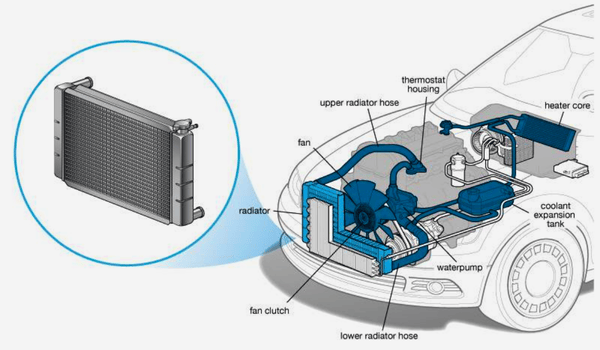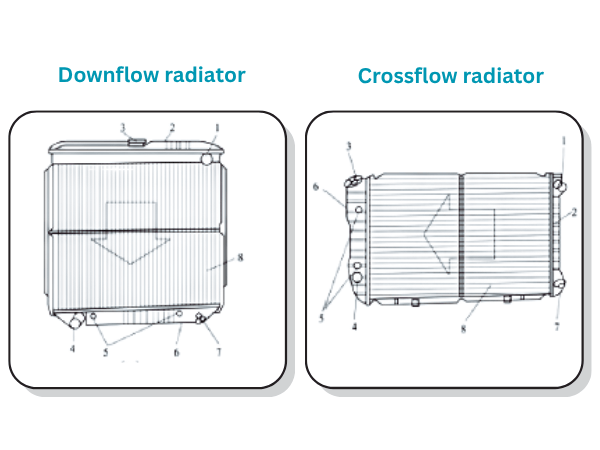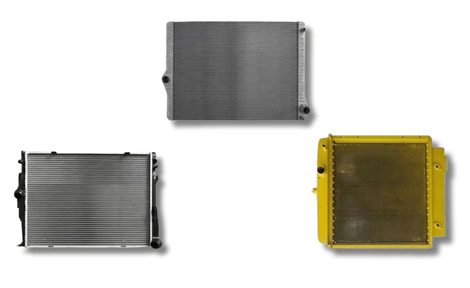As summer temperatures rise, so does the heat under your vehicle’s hood. During this season, your radiator becomes a vital line of defense against engine overheating. If the cooling system isn’t working effectively, high water temperatures can cause engine power loss—or worse, severe damage that leads to costly repairs.
The radiator is the core component of the cooling system. Its job is to dissipate the heat generated by the engine, helping maintain the optimal operating temperature. Understanding how to select the right radiator can help keep your vehicle running smoothly, especially in extreme weather or demanding driving conditions.

1. Fault Diagnosis
Core Cause Tracing
- Surface contamination on the radiator primarily affects airflow between the cooling fins, reducing heat dissipation efficiency. As a result, the heat generated by the engine cannot be effectively transferred away and continues to accumulate, ultimately leading to a rise in coolant temperature.
- Internal blockage of the radiator is typically caused by corrosion byproducts in the coolant (such as scale and rust) or residual sealant, which obstruct coolant flow and further exacerbates temperature increase.
- Persistent high temperatures can cause engine overheating, potentially leading to component deformation, cylinder scoring, and other serious failures, resulting in high repair costs.
2. Radiator Replacement: 4 Key Checks Before You Buy
| Step |
What to Check |
Why It Matters |
| Confirm Vehicle |
Identify the vehicle brand, model, and year of manufacture |
Different vehicles have different cooling system designs; the engine type determines radiator specifications |
| Measure Dimensions |
Length, width, thickness of the radiator; inlet/outlet size and position; mounting hole spacing |
Prevent installation failure caused by size mismatch |
| Performance Requirements |
Assess cooling needs based on driving conditions: regular commuting or frequent high-temperature, high-speed, uphill driving |
Higher usage intensity requires higher cooling performance |
| Installation Space |
Check if the engine bay has enough room; a balance between cooling and installation convenience |
Avoid interference with other components |
Confirming the above four points before purchasing can greatly reduce the risk of installation failure and incompatibility. For example, incorrect dimensions often lead to installation difficulties, and may even require rework or replacement.
3. Radiator Types and Applicable Scenarios
| Material |
Features |
Suitable For |
| Full Aluminum |
Lightweight, excellent heat dissipation, corrosion-resistant, cost-effective |
Performance-focused users, power upgrades |
| Aluminum-Plastic |
Low cost, lightweight, average durability |
Daily commuters, general-use vehicles |
| Copper/Brass |
Superior thermal conductivity, durable, but heavier and more expensive |
Older vehicles or high-load applications |
When selecting a radiator, material choice plays a key role in balancing performance, durability, and cost.
Aluminum radiators are a popular option due to their lightweight and efficient cooling. Choosing the right type depends on your vehicle's use case and performance needs.
4.Radiator structure difference(Downflow vs Crossflow)
Automotive radiators can be classified into two types based on the direction of coolant flow within the radiator: downflow and crossflow, as illustrated below:
- In a downflow radiator, the core is arranged vertically, with the inlet tank located at the top and the outlet tank at the bottom. The coolant flows from the inlet tank downward through the radiator core and then into the outlet tank.
- In a crossflow radiator, the core is arranged horizontally, with the inlet and outlet tanks positioned on the left and right sides, respectively. The coolant flows horizontally from the inlet tank, through the radiator core, to the outlet tank.
| Type |
Coolant Flow Direction |
Features |
Suitable Vehicles |
Notes |
| Downflow |
Vertical flow |
Better strength and mounting reliability |
Older models, trucks, and vehicles with more vertical engine bay space |
Not recommended to switch structure if originally designed as a downflow |
| Crossflow |
Horizontal flow |
Larger frontal airflow area, improved aerodynamics, higher cooling efficiency |
Most modern vehicles, performance mods, and vehicles with wider engine bays |
This type is a top recommendation — especially suited for high-performance vehicles or demanding cooling conditions. |
 1 - Inlet port ;2 - Inlet hose ;3 - Radiator cap; 4 - Outlet port; 5 - Transmission oil cooler inlet and outlet ;6 - Outlet tank; 7 - Drain valve ;8 - Radiator core
1 - Inlet port ;2 - Inlet hose ;3 - Radiator cap; 4 - Outlet port; 5 - Transmission oil cooler inlet and outlet ;6 - Outlet tank; 7 - Drain valve ;8 - Radiator core
5. Effect of Number and Diameter of Tubes on Cooling Efficiency
| Number of Rows |
Applicable Conditions |
Recommendation |
| Single/Double |
Daily driving, light loads |
Original factory specs (usually 1-2 rows) are sufficient, cost-effective, lightweight, and easy to install |
| Double |
High-speed, high-temperature, climbing |
Balanced cooling performance, widely applicable |
| Triple |
Performance cars, heavy loads, modifications |
Ultimate cooling effect, but requires ample airflow and installation space |
More rows increase the coolant flow area and cooling capacity, but also increase radiator thickness, which may affect airflow and installation. When choosing, consider the actual vehicle space and fan capacity.
Car Radiator FAQ
Q1: Is more radiator rows always better?
A: Not necessarily. While increasing the number of rows usually improves cooling capacity, it also increases thickness and airflow resistance, which may reduce ventilation efficiency. If the fan airflow is insufficient or the engine bay space is limited, a multi-row radiator may have the opposite effect. Always confirm compatibility with installation space and cooling system before choosing a multi-row radiator.
Q2: How do I evaluate a radiator’s cooling performance?
A: Consider three main factors: the size of the cooling surface area, the fin density, and the design of the internal coolant passages. These directly affect cooling efficiency. For performance vehicles or use in high-temperature environments, it’s recommended to prioritize radiators with optimized structures for higher efficiency.
Q3: How can I confirm if a radiator fits my car?
A: The key is to check the connection points and installation details, including fan mounting holes, sensor interfaces, and the size and position of the inlet and outlet ports. Incorrect dimensions can cause installation difficulties or make the radiator unusable.
Q4:Are brand and warranty really that important?
Absolutely. A reputable brand not only guarantees better workmanship and performance, but quality products usually come with a 1 to 2-year warranty, providing timely and effective after-sales support for greater peace of mind.










